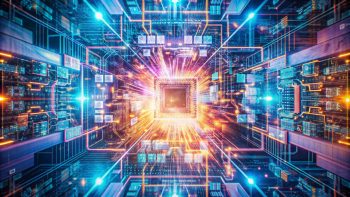
Written by: Nik Faiz Nik Ruzman, Journalist, AOPG.
Over the years, cloud computing has become the go-to solution for businesses seeking flexibility and scalability. It has allowed companies to achieve remarkable feats without investing in their own hardware, including adopting Artificial Intelligence (AI) capabilities. However, when it comes to truly pushing the limits of AI innovation, traditional cloud environments may not always cut it.
Companies exploring more advanced AI projects may require something more powerful. At the other end of the spectrum lie supercomputers—might they be the answer?

Joseph Yang, General Manager of HPC & AI at Hewlett Packard Enterprise
According to Joseph Yang, General Manager, HPC and AI, APAC and India at Hewlett Packard Enterprise (HPE), the difference lies in sheer computational power. “Supercomputers outperform traditional cloud architectures in handling large-scale AI models through several key advantages, like parallel processing, high-speed data access, and specialised hardware accelerators,” he explained.
These key advantages laid out by Yang imply that supercomputers if you take a moment to think about it, are actually a lot more powerful than you think. At the core of it, what makes them truly tick is their ability to harness thousands of processors working together. But it’s not just about the numbers – these systems are built for AI.
The parallel processing enables them to simulate vast amounts of complex calculations simultaneously, not to mention the support of specialised hardware accelerators like GPUs and TPUs, which handle the heavy lifting when it comes to deep learning.
Supercomputers bring the massive computational power that complex AI tasks demand. For operations working with advanced AI models, this means faster training, more accurate simulations, and the ability to tackle problems that would be nearly impossible on regular computing or cloud systems.
Engineers’ and Scientists’ Playground: When Speed and Power Matter Most
Imagine trying to sift through billions of data points or run complex AI simulations that could take months on a traditional platform. Supercomputers, however, are built to handle such massive tasks in a fraction of the time!
Yang explains, “Supercomputers can allocate all computing resources to a single workload, making it more efficient, reliable, and accurate—especially when it comes to training and tuning AI models.”
An example laid out by Yang is within the healthcare sector, aiding drug discovery, genomic analysis, and disease modelling via massive calculations and simulations at incredibly high speeds, processing vast datasets that traditional computers cannot handle.
Other use cases of supercomputers can be found across various industries as well. Scientific researchers can leverage supercomputers to achieve unique breakthroughs through complex simulations, including weather forecasting and climate modelling.
The automotive and aerospace sectors are eager to adopt this technology as well, using it for advanced simulations in vehicle design, crash testing, and aerodynamics. Even financial services utilise this technology heavily, such as in high-frequency trading, extensive risk analysis, and seamless fraud detection.
So, what can we take away from these use-case examples? One thing’s for sure; this is a life-changing mechanism that has broken the glass ceiling of enhanced data analysis and modelling capabilities.
It’s not just an improvement in terms of economic efficiency; it’s changing our lifestyle all around, giving us future possibility to discover solutions to every corner of the world’s problems that seemed hopeless to unravel for many, many years.
Power Drainers: Can They Achieve Sustainability?
Short answer – yes.
It’s easy to think of supercomputers as energy-hungry beasts, but the truth is that they’re also evolving to meet sustainability goals. Yang points out that HPE is pioneering energy-efficient supercomputers that balance performance with sustainability.
“To leverage the power of supercomputers while meeting sustainability goals requires a holistic approach to optimising energy efficiency through the design and operation process,” Yang explains.
Yang set an example of HPE’s approach which includes technologies like liquid cooling systems that reduce energy consumption by keeping supercomputers from overheating. Their QScale QO1 data centre in Quebec, for instance, runs on nearly 100% renewable energy, making it a model for future AI infrastructure.
But the real game changer? AI for data centre operations (AIOps). This approach uses AI to optimise the very systems that power AI, creating a virtuous cycle of efficiency. By streamlining resource use and identifying inefficiencies in real-time, AIOps ensures that supercomputers are not only powerful but also as green as possible. The result? An AI-driven future that doesn’t come at the planet’s expense!
Big Shoes to Fill: The Ferrari in a World Full of Fords
Not every company needs that much firepower. For smaller enterprises, supercomputers might just be overkill. It’s like buying a USD $20,000 PC to run Microsoft Word – it’ll do the job, but is it worth the spend?
So when you’re thinking about diving into the world of supercomputers, Yang breaks it down with a checklist:
- How Big Is Your Data?
If your business deals with massive data sets or complex simulations, supercomputers might be a game changer. - Need for Speed?
When you need fast processing times and huge simulations, supercomputers are your go-to. - Training AI Models In-House?
If you’re building advanced AI models from scratch, supercomputers offer the power you need to get it done. - Do You Have the Right People?
Running a supercomputer isn’t easy. “Only 10% of enterprises have the expertise to handle supercomputing resources effectively,” Yang points out. For the rest, partnering with a company like HPE is a smart move.
The Bigger Picture: Extremely Powerful, But Not for Everyone
Supercomputers are undeniably powerful, but they’re not for everyone. If you’re running smaller AI projects and lack the infrastructure to support such a system, a combination of on-premises solutions or standard cloud services might be all you need. With Yang’s insights, one thing we can summarise is – supercomputers are for enterprises with large-scale AI ambitions. If your AI workload isn’t pushing the envelope, you might be better off sticking with cloud solutions or hybrid infrastructures.
In the coming years, supercomputers will undoubtedly play an important role in solving some of the world’s most complex problems. While not every business may require this level of computing today, staying aware of advancements in this field will ensure you’re prepared for the future. As the demands for greater processing power grow, so too will the potential for supercomputers to shape industries and drive breakthroughs.
 (0)
(0) (0)
(0)Archive
- October 2024(44)
- September 2024(94)
- August 2024(100)
- July 2024(99)
- June 2024(126)
- May 2024(155)
- April 2024(123)
- March 2024(112)
- February 2024(109)
- January 2024(95)
- December 2023(56)
- November 2023(86)
- October 2023(97)
- September 2023(89)
- August 2023(101)
- July 2023(104)
- June 2023(113)
- May 2023(103)
- April 2023(93)
- March 2023(129)
- February 2023(77)
- January 2023(91)
- December 2022(90)
- November 2022(125)
- October 2022(117)
- September 2022(137)
- August 2022(119)
- July 2022(99)
- June 2022(128)
- May 2022(112)
- April 2022(108)
- March 2022(121)
- February 2022(93)
- January 2022(110)
- December 2021(92)
- November 2021(107)
- October 2021(101)
- September 2021(81)
- August 2021(74)
- July 2021(78)
- June 2021(92)
- May 2021(67)
- April 2021(79)
- March 2021(79)
- February 2021(58)
- January 2021(55)
- December 2020(56)
- November 2020(59)
- October 2020(78)
- September 2020(72)
- August 2020(64)
- July 2020(71)
- June 2020(74)
- May 2020(50)
- April 2020(71)
- March 2020(71)
- February 2020(58)
- January 2020(62)
- December 2019(57)
- November 2019(64)
- October 2019(25)
- September 2019(24)
- August 2019(14)
- July 2019(23)
- June 2019(54)
- May 2019(82)
- April 2019(76)
- March 2019(71)
- February 2019(67)
- January 2019(75)
- December 2018(44)
- November 2018(47)
- October 2018(74)
- September 2018(54)
- August 2018(61)
- July 2018(72)
- June 2018(62)
- May 2018(62)
- April 2018(73)
- March 2018(76)
- February 2018(8)
- January 2018(7)
- December 2017(6)
- November 2017(8)
- October 2017(3)
- September 2017(4)
- August 2017(4)
- July 2017(2)
- June 2017(5)
- May 2017(6)
- April 2017(11)
- March 2017(8)
- February 2017(16)
- January 2017(10)
- December 2016(12)
- November 2016(20)
- October 2016(7)
- September 2016(102)
- August 2016(168)
- July 2016(141)
- June 2016(149)
- May 2016(117)
- April 2016(59)
- March 2016(85)
- February 2016(153)
- December 2015(150)

